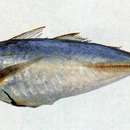Diagnostic Description
provided by FAO species catalogs
Body elongate, moderately slender and slightly compressed. Eye Moderate, with adipose eyelid well developed, completely covering eye except for a vertical slit centred on pupil. Scales on top of head do not extend forward to beyond centre of pupil. Lateral line anteriorly with a low regular arch, with junction of curved and straight parts below second dorsal fin between 11th to 13th solf rays; scales in curved part of lateral line 42 to 62; scutes in curved part 0 to 4; straight part with 0 to 4 scales, followed by 30 to 40 scutes (total scales + scutes excluding caudal scales: 77 to 102). Oral valve (membrane) at symphysis of upper jaw dusky or transparent; posterior end of upper jaw straight above, slightly concave and not noticeably slanted anteroventrally. Both jaws with an irregular row of minute teeth nteriorly and a single series posteriorly. Gillrakers (including rudiments) 10 to 14 upper, 30 to 39 lower and 41 to 53 total on first gill arch. Shoulder girdle (cleithrum) margin wirh 2 small papillae, the lower papilla the larger. Two widely separate dorsal fins, the first with 8 spines, the second with I + 28-33 soft rays (including finlet). Anal fin with 2 detached spines followed by I + 25-29 soft rays (including finlet); terminal dorsal and anal soft rays each consisting of a widely detached finlet. Pectoral fin 76.5 to 97.0% of head length, tip of appressed fin falling short of to slightly beyond a vertical line from second dorsal fin origin. Colour in life, bluish-green above, silvery below; small black blotch on margin of opercle near upper edge. Caudal fin hyaline to dusky brown, second dorsal fin hyaline bassally, light dusky distally; other fins mostly hyaline, except pelvic fins of adult males slightly dark.
Fischer, W.; G. Bianchi (eds.). - 1984FAO species identification sheets for fishery purposes. Western Indian Ocean (Fishing Area 51). Prepared and printed with the support of the Danish International Development Agency (DANIDA). Rome, Food and Agricultural Organization of the United Nations, Vol. I-6: pag. var. Fishbase: ICLARM .
Distribution
provided by FAO species catalogs
Broadly distributed throughout the Western Indian Ocean and from Japan to Australia in the Western Pacific Ocean.
Size
provided by FAO species catalogs
Maximum largest specimen examined 35 cm fork length; common to about 20 cm fork length.
Brief Summary
provided by FAO species catalogs
Pelagic, the most common Indian Ocean Decapterusin coastal waters and on open banks at depths not exceeding 100 meters.Feeds primarily on smaller planktonic invertebrates. Reaches sexual maturity during the first year of life at about 12 cm total length.
Benefits
provided by FAO species catalogs
Coastal waters throughout its range. Caught with purse seines and trawls. Fish of 15 cm total length (average weight 50 g) and 2 to 3 years of age are the most frequent in catches. The total catch reported for this species to FAO for 1999 was 159 863 t. The countries with the largest catches were Thailand (82 000 t).and Malaysia (70 160 t) Markered fresh may be dried or salted; also sold frozen and canned.

